Guatemala: The Aftermath of Civil War
Article and photos by Veronica Hackethal
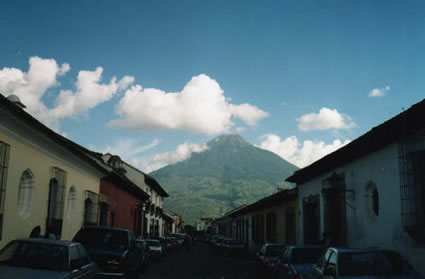 |
| Volcano seen from a street in Antigua. |
Guatemala City, July 1997. It is six months since the Peace Accords ended 36 years of civil war. An uncertain cease fire exists between rival guerilla forces of the URNG (Unidad Revolucionara Nacional Guatemalteca) and the Guatemalan military. Heavily brokered by the UN, peacekeepers enforce the agreement. A spirit of fear pervades Guatemala’s capitol: fear of violence, fear of crime, fear of death. I am an idealistic pre-med from Los Angeles, and arrive in Guatemala City for the summer to work at Rodolfo Robles V Hospital. The most I know about hospital work, war, and crime comes from TV shows and movies. I do not know what to expect. How true are the warnings about the dangers of Guatemala City?
On my first day I meet the family from whom I rent a room in Zona 11, a middle class neighborhood outside the city center. On first sight, the area looks like many American middle class neighborhoods. But mistrust burdens the air. Since the ceasefire, three thousand guerillas have been demobilized, and crime in Guatemala City is rampant. The week before I arrive, a man was gunned down a few blocks from this family’s house. His life was cheap. The murderers wanted his car, so they shot him in the chest.
Guatemala’s geography plays a role in the violence: the country lies at the crossroads of North and South America. According to the CIA World Factbook, Guatemala is a major transport country for cocaine and heroin. Money laundering and corruption are widespread, and the country is on the CIA’s Tier 2 Watch List for human trafficking in sex workers (both men and women) and forced labor.
If I wanted to write about being warmly welcomed by the locals, this story would not be it. When Tolstoy wrote, “Happy families are all alike; every unhappy family is unhappy in its own way,” he could have been referring to the family with which I stay. This family is war-torn, like Guatemala. It is a house of women: a grandmother, a daughter, three young grand-daughters, and a Mayan domestic at whose delicate smallness I marvel. She smiles at me shyly from a room at the back of the kitchen where she spends her days. My first impression of the grandmother: a stern, critical woman, difficult to please. I wonder if she has takes boarders for extra money and resents needing to do so. She seems begrudging about the job, and we start out on the wrong foot. I am accustomed to wandering when I travel, a freedom I take for granted as an American woman. On my first afternoon, I decide to go for a walk. “Toda sola?” she responds, her face registering disapproval. I nod innocently. She shrugs, dismissively throws up her hands and walks away. I head out feeling confused: she has not offered any explanation for her behavior.
The neighborhood is a series of compounds. Houses huddle together, encircled by fences cinched in the front by gates and guards’ sheds. Armed guards, rifles swung over their shoulders, frown seriously, stop cars to survey their contents, waving them through once approval has been met. The house where I stay lies outside these compounds. It stands isolated, exposed and unsheltered from potential violence. I rent a room on the ground level: a Spartan, solitary room at the front of the house. At night, I am left alone, writing in my journal as the family retreats upstairs.
In a country where the divorce rate hovers around 0.13% (the lowest in the world), I manage to end up in a broken home. The daughter, in her early thirties, is in the thralls of divorce. I rarely see her. She and her mother fight often. Sharp words and tension between the two thickens the air. The three little girls shyly stay out of the way. They spend most of their time withdrawn upstairs, playing quietly while TV murmurs in the background. In that house, I feel unwanted; another unwelcome American presence in a long line of bungled US interventions in Guatemalan affairs.
In the evenings, I read about how US Green Berets trained the Guatemalan military in the 1950s. They did their job well. Guatemala’s military became one of the best trained in Central America. Their strong point: repressing civil unrest. The Historical Clarification Commission estimates that during the civil war the Guatemalan military committed 93% of the human rights abuses (death squads, summary executions, forced disappearances, torture). In the last decade of the war, 669 major massacres of indigenous Mayans occurred; a tragedy that many assert was a deliberate attempt to exterminate indigenous peoples, which fulfils the definition of genocide. The civil war killed 200,000 mostly unarmed civilians, and created an international Guatemalan Diaspora, most of whom (approximately one million) fled to the US. Hotbeds for the violence lay in the Highlands and in Guatemala City.
The first week I adjust to life in Guatemala City. I learn to turn on the heater above the shower at least ten minutes before washing. This warms the water, which otherwise emerges as an arctic stream. One morning as I pull on my clothes they feel stiffer than usual: my t-shirt and jeans have been starched and ironed. My jeans have pleats. On the kitchen table breakfast awaits: frijoles negros and rice. The house is silent and dim. I sit quietly, eating alone, wondering why I came here.
During the day my work reveals a different reality of life in Guatemala City. Having clean clothes, warm water for a shower every morning, and food waiting on the table are luxuries for many here. I walk in my crisply starched clothes alone to the hospital. Halfway there, another summer employee waits in front of the stationary store. I instantly love the place. The store is small and narrow — an extension of the two houses between which it nestles. The store is dusty. Dim light filters in from the street, but cannot obscure the splashes of cheerful color radiating off the shelves. Writing implements beckon, offering the hope of self expression: colored pencils, fluorescent erasers, hot pink and fiery orange paper, stickers of fairies and unicorns popular for prettying up notes to best friends (a lingering romantic impulse to which young girls the world over cling.)
Back in 1997, I had yet to learn the defenses necessary for surviving in a hospital: blocking the part of myself that still has trouble stomaching the smells, the misery-filled eyes, and the never ending need of the sick and dying. I can still picture my first glimpse of the eye clinic. Lines of patients — there is a reason for calling them patients — snake along a turquoise wall (the colors of hospital walls vary depending on the country, I have since learned). There are no seats or benches. A Mayan boy lifts his face as I pass. An opaque aquamarine orb occupies the socket of his left eye. Yellow fluid oozes from the outer corner. I have difficulty looking at him, and yet cannot look away. His image sears a hole in my memory. Since then, I have sometimes wondered what happened to that boy. Was his eyesight saved?
Most days are spent outside the hospital in the slums which cascade precariously down the hillsides above Guatemala City. I work on medical research about scabies. The slums are prime breeding grounds for the parasite. Most scabies treatments only require one dose, but in highly infested areas, a second treatment is needed. So we make an initial visit and then return two weeks later for the second dose. We also take urine samples, checking for blood in the urine. A high incidence of childhood skin diseases has been linked to chronic kidney damage, a silent killer that leads to kidney failure later in life (scratching the skin sores introduces other bacteria, which can attack the kidneys, into the blood stream.) We investigate whether treating scabies decreases the number of children with blood in their urine.
In an old pickup truck we chug along muddy, unpaved roads to the hilltops. Slum residents live in low, dirt-floored huts without running water or electricity. I wonder how these huts stay put. It seems like the first downpour would bring them slithering down the hills into the city below. This premonition becomes true. In 2005, a mudslide collapses an entire hillside, killing many residents. In 2007, a sink hole opens up, claiming more lives.
We set up shop and the children’s arrival begins in a trickle. They peer curiously around the corner of our makeshift medical clinic. Suddenly the atmosphere explodes into a carnival. Children surround us, giggling deliriously and acting as though we are handing out cotton candy. Their mothers stand aside, waiting patiently for the free medicine.
Lack of collection cups for the urine hampers our work. We use plastic bags, which makes the work tenfold messier. I assist the mothers in collecting urine samples from the children and learn that Guatemalan children are like American ones in this respect: most of them miss their mark. Urine usually covers my hands. Water taps are scarce in these villages and my hands stay soiled all day. I learn not to touch my face with them. One afternoon while returning to the hospital, our truck groans pitifully, and then dies. The driver (a Guatemalan doctor) fidgets nervously. We have been told that being marooned in the slums after dark courts danger. He curses, fiddles with the engine, three of us then push from behind, and with triumphant shouts of relief the engine springs back to life before dusk.
I wonder about the ethics of our work. What difference does it make to have a temporary presence in these places? Once treated, these children return to the same huts that still harbor scabies, where the parasites infect them again at night when they sleep. I have further reservations: informed consent does not exist in the slums of Guatemala City. And then a disconcerting thought: are we just entertainment to people already resigned to the privations of social marginalization? These problems lie in the social fabric of the place, and cast dark shadows over our work.
The days settle into a routine. Weekdays we work in the slums, delivering medicine, then return to the hospital to process urine samples. Evenings, we report back to our respective houses, which for me means an evening of quiet and solitude. Fear of violence confines us during the night. But routines, like rules, are meant broken. A coworker invites me to watch “The Wizard of Oz” dubbed in Spanish and played backwards (all the rage that summer — reverse play supposedly reveals secret messages encrypted in the film.) I arrive to a house filled with activity and sound. This family is intact. They live in one of the security compounds, and this sense of safety lightens the mood. We sprawl on the living room floor, eating popcorn and laughing, unable to find the hidden messages. The movie ends and I linger, not wanting to separate. A moment’s hesitation and parting becomes inevitable. Fear flickers over the father’s face about the prospect of driving after dark, but he bravely does the job. He waves goodbye with a smile while I open the door to a dark and silent house. No light has been left on for me.
On the weekends, the other summer workers and I explore the city, taking precautions against crime. We travel in a group and have been warned to avoid notoriously dangerous areas of the city (which includes Zona 1, the historical center: we skip the Plaza Colonial, the Central Market, and the Palacio Nacional.) We also escape to the countryside, where we stay on the beaten path. We avoid the chicken buses and those running at night. Hopping on direct daytime routes, we head straight to our destinations: tourist spots, well-policed, and safe for foreigners who offer up wads of cash.
One weekend we visit Antigua, the former capitol destroyed by an earthquake in 1773 when the capitol was moved to modern-day Guatemala City. Going to Antigua feels like entering a time capsule. Ruins of colonial Spanish buildings dot the city. Just as memorable is the freedom of wandering the cobble-stoned streets at night.
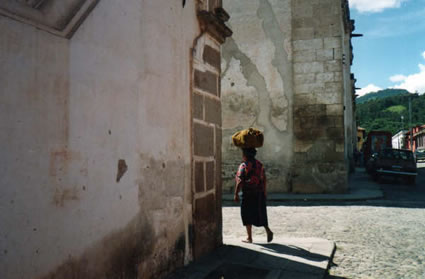 |
| Mayan woman in Antigua. |
We meet up with several Guatemalan medical students who work in rural clinics during the week. They are attending a cousin’s wedding at Antigua’s Hotel Casa Santo Domingo. Once a convent, it has been reincarnated into a romantic luxury hotel. The wedding reception is held among the hotel’s own ruins, and we crash the party. We dance to the beat of a Spanish band, flown in for the occasion. As we walk back to our hotel ($18 a night), our bellies bursting with food from the reception’s buffet, we pass the ruins of a cathedral. The bass from a rock concert reverberates off the cobble stones. The contradiction between the riches of Antigua and the poverty of the Guatemala City slums boggles the mind. I cannot make sense of the disparities and feel uncomfortable returning to the loneliness of that house in Guatemala City.
Another weekend we head to Livingstón, a port on the Caribbean coast reachable only by boat from Puerto Barrios. The express bus to Puerto Barrios cuts through the highlands, and I gaze at the electric green hills. The bus lives up to its name — six hours nonstop. In Livingstón, we sleep in palapas directly on the beach, a haven of tranquility. Our beds have mosquito nets. In the evenings, we rejoice in freedom. We grow lazy in the warm evening breezes and doze to the lullaby of the waves.
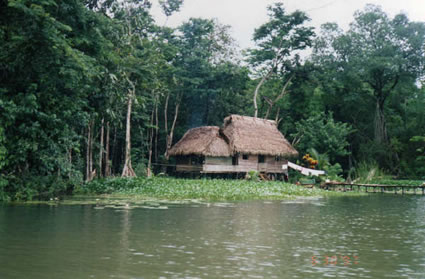 |
| A hut off the Caribbean coast. |
Livingstón has a large Garifuna population, a mix of African slaves, Carib, and Arawak Indian. Their language is unique — a split vocabulary separates words used only by men from those used only by women. We explore the neighboring areas by boat: emerald jungle hangs low over the water, an old Spanish fort crawls with orchids, and the harangue of birds breaks the silence.
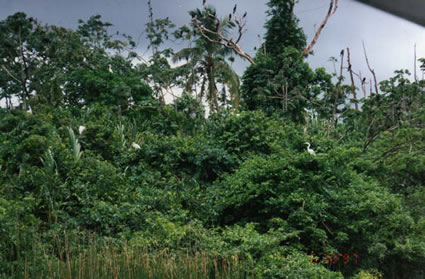 |
| Jungle and birds off the Caribbean coast. |
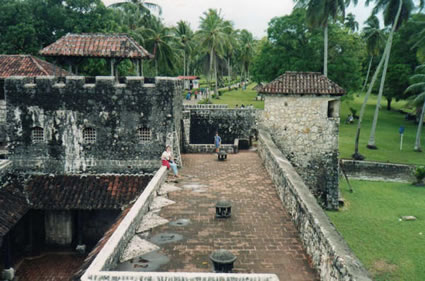 |
| A fort near Livingstón. |
Returning to Guatemala City, I feel even more like an interloper. I know I am lucky. I can escape for the weekend, or forever. I can go home. The family with whom I live, and the people in the slums, cannot escape. They are already home, as imperfect as it may be.
During my last week, I rebel against the night-time confinement and furtively head to Galerias Milaflores, a shopping mall that boasts a Cineplex of eight theatres. The first movie playing is Disney’s Aladdin. Finding a seat is easy in the empty theater, and I immerse myself in a dream world, savoring the escape. The movie ends and I jolt back to reality: I am alone, having fled without a plan for returning to that house. Ricardo Montaner singing “Un Mundo Ideal” (the Spanish version of Aladdin’s “A Whole New World”) echoes inside my head as I hop in a cab, knowing that I take a risk. I have been warned that people are robbed or kidnapped by cab drivers at night in Guatemala City, a place far from ideal. All the streets look the same at night, and I start to feel lost, my heart thumping frantically. But my driver is honest. He circles round and round until we finally find the house. The downstairs are dark and empty. Everyone has gone to sleep. It is as if my absence had not even been noted.
That summer was filled with first impressions: the aftermath of war and rampant crime, the soul-crushing work of medicine, and the loneliness of being an unwanted visitor. To cope, I poured myself into my journals, which helped develop my identity as a writer. This self-knowledge has taken more than ten years to crystallize. Traveling more widely since then has added other perspectives and allows me to be more objective. The family with whom I stayed was recovering from crisis, just like Guatemala had been for so long. It had nothing to do with me. It had everything to do with history and politics, and the power of the North that I represented. The somber mood in Guatemala City that summer was testament to extreme narcissism: I am strong, I am more important than you, I will prevail, and I will crush you if you think otherwise. In a New York Times article dated July 18, 1982, General Rios Montt hammered home this rampant negativism to an audience of indigenous Guatemalans: “If you are with us, we will feed you; if not we will kill you.”
That summer, anger ruled Guatemala City and that family. Even though I personally experienced no real danger, fear alone explains the repeated warnings and restrictions that I encountered. In “Men of Maize: The Modernist Epic of Guatemalan Indians,” Nobel Prize laureate Miguel Angel Asturias taps into this rage: “In the grass was a mule, on the mule was a man, and in the man was a dead man…he drank to feel himself burned, buried, beheaded, which is how you have to go to war if you want to go unafraid: no head, no body, no skin.” That summer revealed that no one wins a war, not even those on the “winning” side. War leaves a legacy: a fundamental inability to have faith in one’s fellow man. Sometimes I wonder where that family is now. I wonder where Guatemala City is now. I wonder if healing has become possible. Despite the discord, I would like to return, to sit outside on a warm summer night in Guatemala City and feel safe.
Veronica Hackethal has lived in a hut on the African savannah, worked in a hospital in Guatemala City, made a half circle of the Mediterranean from Morocco to Turkey, slept under the stars in the Australian outback, and gotten her rental car stuck in the capillaries of a mountain top village in Sicily. She is originally from Los Angeles and studied anthropology at Harvard and Oxford universities. She currently lives and writes in Washington Heights, New York City.
|
